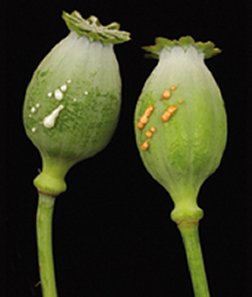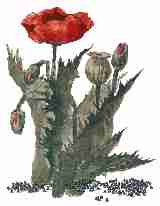Morphine-free Mutant Poppies:
Susan Milius
Novel plants make pharmaceutical starterHIGH-LOW. The seed capsule of a natural morphine-producing poppy (left) oozes sap that's whiter than the latex of the morphinefree poppy mutant (right). CSRIO
A Tasmanian company has developed a poppy that produces a commercially useful drug precursor instead of full-fledged morphine, and an international research team has now reported how the plant does it.
The top1 mutant of the opium poppy (Papaver somniferum) came out of a company research effort in 1995, but scientists haven't previously published studies of this mutant, says Philip Larkin of the plant-industry section, in Canberra, of CSIRO, Australia's federally funded research agency.
In the top1 mutant, the poppy's natural chemistry has a glitch that stops the normal process of making morphine, which is prized as a drug by itself and as a raw material for opiates such as heroin. As a consequence of the synthetic pathway's breakdown, top1 accumulates two intermediate compounds: thebaine and oripavine.
To make some modern painkillers and addiction treatments, pharmaceutical companies convert morphine back to thebaine and then process it further. Starting with thebaine is more efficient, Larkin says. The Tasmanian drug industry has been using top1 since 1998 for production of buprenorphine, oxycodone, naloxone, and naltrexone.
In top1, Larkin and his colleagues have now pinpointed blockages in two arms of the poppy's chemical pathways. The team describes its work in the Sept. 23 Nature.
Peter Facchini of the University of Calgary in Alberta, who studies poppy biochemistry, says that for figuring out details of natural morphine synthesis, the new poppy is a "very useful tool."
The Australian island of Tasmania grows some 40 percent of the world's legal poppy product. To create more-desirable varieties, Tony Fist of the company Tasmanian Alkaloids in Westbury treated poppy seeds with a chemical mutagen. He then screened the seedlings and found the top1 poppy.
The company "must have set a land speed record for commercialization," says Larkin. As early as 1997, Tasmanian growers turned to the top1 poppy to sell to pharmaceutical companies.
The researchers gave seedlings radioactively labeled doses of components in the natural morphine pathway. By testing where the radioactivity showed up later in the pathway, the team found the glitch at the step that removes a methyl (CH3) group from thebaine and oripavine.
Larkin and Anthony Millgate, also of CSIRO, compared the activity of some 17,000 individual genes in the mutant and the natural poppies. The mutant's activity fell short for 10 of the genes.
Low-morphine mutants are common, especially for ornamental gardens, Facchini says, but it's rarer to find a mutant that accumulates something useful.
Plant biochemist Vincenzo De Luca of Brock University in St. Catharines, Ontario, says, "The story shows there is still much to be done when it comes to improving medicinal plants."
References:
Millgate, A.G. . . . A.J. Fist, and P.J. Larkin. 2004. Morphine-pathway block in top1 poppies. Nature 431(Sept. 23):413-414. Abstract available at http://dx.doi.org/10.1038/431413a.
Sources:
Vincenzo De Luca
Department of Biological Sciences
Brock University
500 Glenridge Avenue
St. Catharines, ON L2S 3A1
CanadaPeter Facchini
Department of Biological Sciences
University of Calgary
Calgary, AB T2N 1N4
CanadaPhil Larkin
CSIRO Plant Industry
Black Mountain
P.O. Box 1600
Canberra, ACT 2601
Australia
HOME
Opium
Images
Opium War
Top1 Mutants
Opium People
The SuperPoppy
Opium Timeline
Painkillers/brain
Just For Chemists
The Golden Route
Opium Advertisement
The Afghan Connection
Heroin: A Drug Fit For Heroes?
Confessions of an English Opium Eater

